Operation Strategy
Intelligent operation strategies are core elements in creating cost-effective energy systems. The layout of the “Operation Strategy” editing window is closely connected to the “Electricity markets”.
You have the option to choose between automatic calculated operation strategy (Minimizing Net Production Cost (NPC)) and user defined (User Defined Operation Strategy).
The description of the operation strategy in this chapter relates mostly to the Analytic calculation method. The MILP calculation method calculates the operation strategy in bit different way. MILP does not calculate according to net heat production cost, but is aiming at optimizing the overall result. This means that MILP is able to optimize a variety of problems, where the Analytic is best at optimizing projects including heat and cooling. For more information on the MILP, please look up the how to guide: “The MILP Solver optimization method in energyPRO” at emd.dk.
The figure below shows two examples of operation strategy editing windows for a project with no cooling demand.
The upper example is a project with a user defined operation strategy optimized on a flat rate electricity market, while the lower shows a project with an automatic calculated operation strategy optimized against a day ahead market.
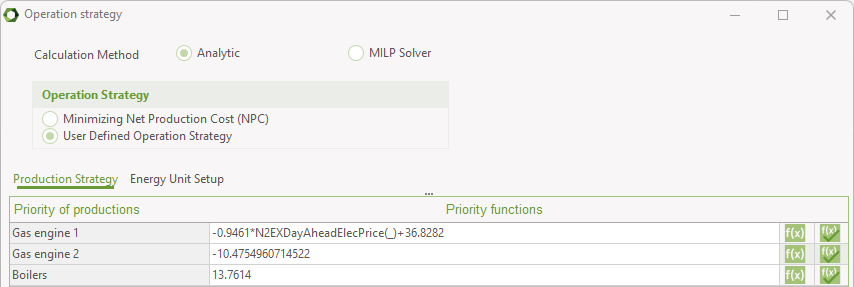
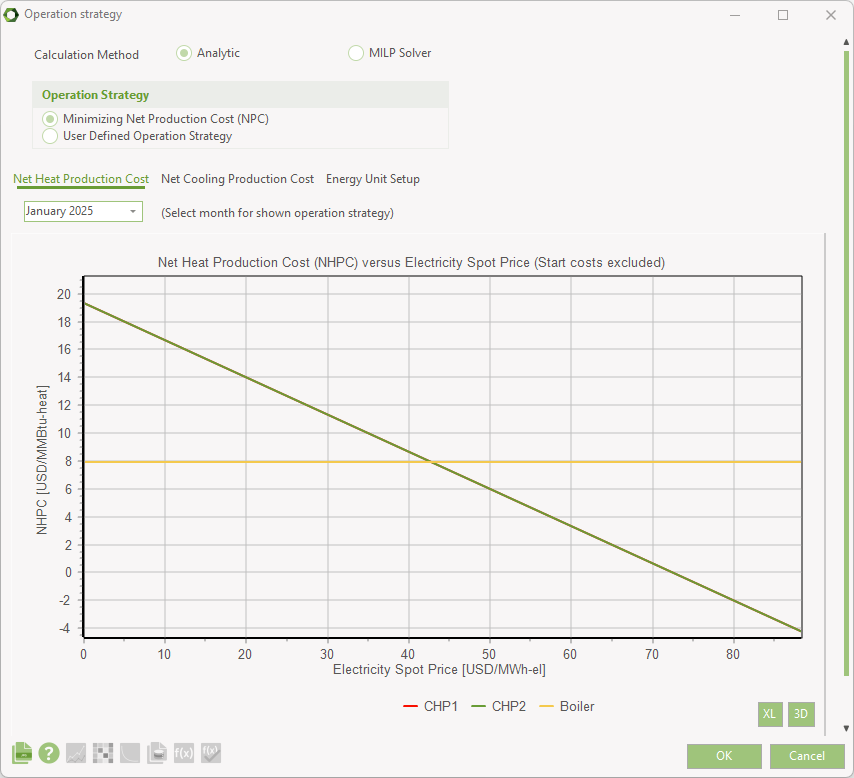
energyPRO calculates the optimisation period (month or year) several times. First, it calculates the optimisation period with only the energy units with top priority (e.g. the lowest number) in operation in the considered time interval. Hereafter it calculates the optimization period adding the energy unit with next highest priority in operation, etc. This iterative technique is using the priority set-up in the Operation Strategy.
The two examples above are without a cooling demand or fuel producing units enabled. If a cooling demand is added together with cooling producing units, e.g. Electric chillers, a new tab for the “Net Cooling Production Cost” will be added to the operation strategy. This tab will be similar to the tab “Net Heat Production Cost”, except that it will show the priority of production of cooling at different electricity prices. Similar if “Fuel producing energy units in project” has been enabled in the “Project Identification” a tab called “Consumption strategy” will appear, in which you can define the max allowed priority number of the fuel producing unit, which is the highest priority number in the Production Strategy the units consuming the fuel produced will allow the fuel producing unit to run at.
For the shown auto calculated operation strategy above, the tab “Energy Unit Setup” looks as shown below.
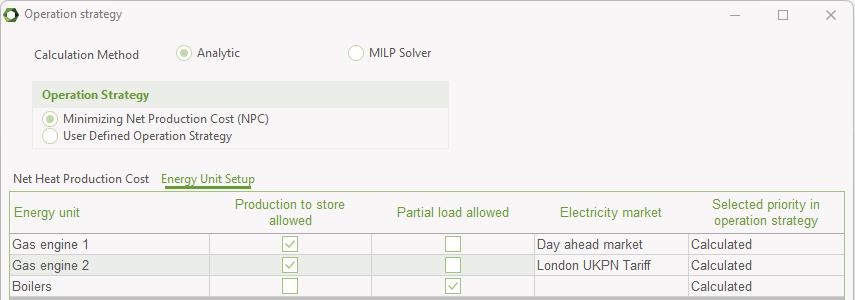
Heat Rejection allowed: This section is visible only if a heat rejection unit is added. You check the production unit(s) that has access to the heat rejection unit.
Miscellaneous: The Operation Strategy window changes its appearance dependent on the following factors:
- Does the project include electricity demand
- Does the project include thermal storage
- Does the project contain transmissions
- Is the operation strategy calculated automatic
You have to check allowances and restrictions towards these options. E.g. is the production from an energy conversion unit allowed to be transmitted to another site? Which energy conversion units are allowed to produce to thermal store? Which energy conversion units are allowed to run on partial load etc.?
Operation strategy
You have to decide how your “Operation Strategy” should be set up. There are two options “Minimizing Net Production Cost”, which automatically will fill in numbers in the Priority table, and “User Defined Operation Strategy”. There are three situations depending of selected wholesale market
- No wholesale electricity market present in project
- Whole sale market is a fixed tariff market
- Whole sale market is a spot market
Operation strategy if no electricity market is defined
The figure below show an operation strategy in a project, where there is no electricity market defined. In the user defined (upper) part you simply state the priorities for the production units. In this example the Heat Pump gets the top priority, here 1 (lowest number) and the boiler priority 2 covering the residual demand. In the automatic calculation (lower) the priorities are calculated automatically. In the example the operation cost of the HEat Pump is calculated to 12 €/MWH-heat and the production cost on the boiler is calculated to 29€/MWH-heat .
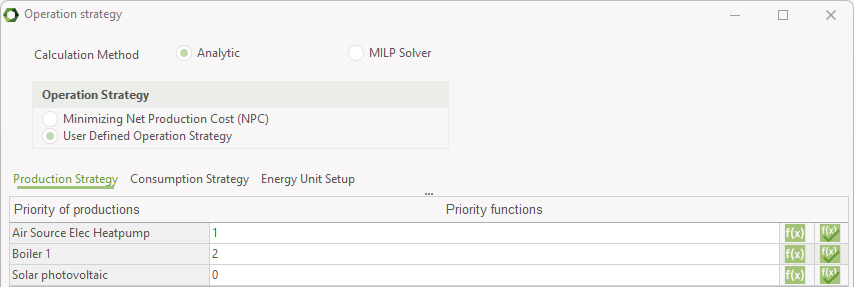
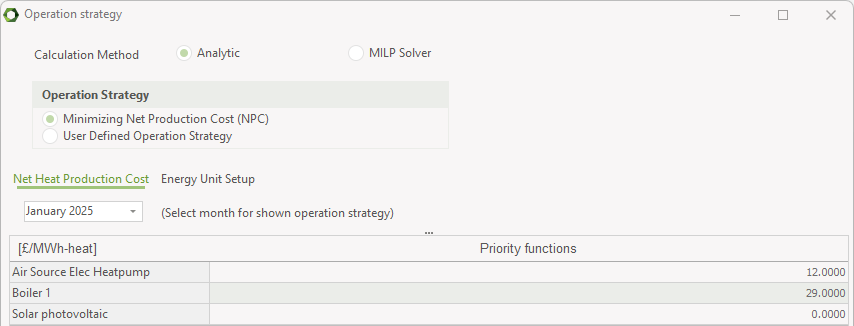
Operation strategy if the electricity market is a fixed tariff market
The figures below shows an example of an operation strategy, where the wholesale market is a fixed tariff market. If “Minimizing Net Production Cost” is selected then the Operation Strategy will be calculated based on the “Operation Expenditures” and the “Revenues” that you have defined in your “Economy”. Hence, it is of crucial importance that these are made accurate. These priority numbers cannot be edited while “Minimizing Net Heat Production Cost” is selected. Choosing “User Defined Operation Strategy” hereafter will keep the calculated values and make the table editable.
The functionality of “Minimizing Heat Production Cost” is described in the next section.
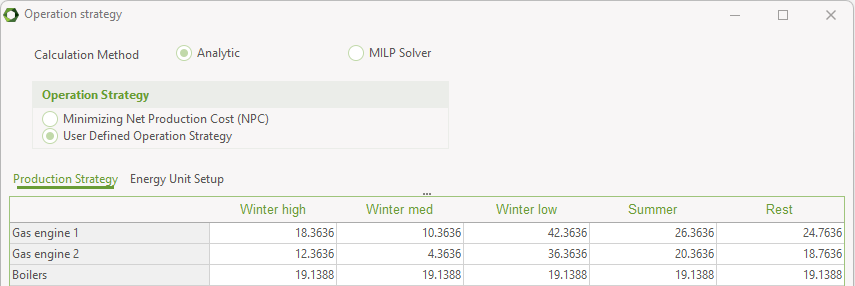
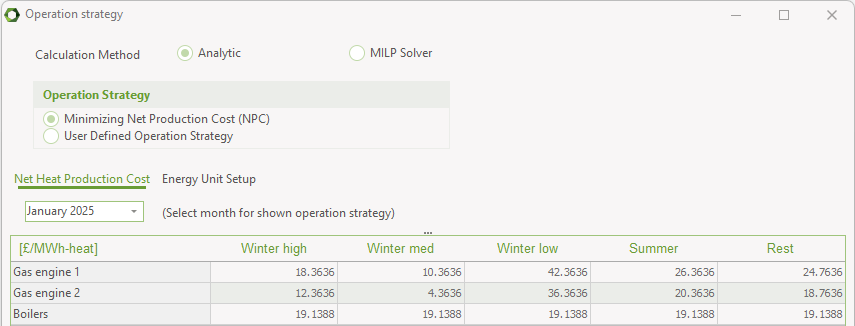
Operation strategy if Electricity market is “Spot market”
If the “Electricity market” is “Spot market”, the Operation strategy window is different depending on whether “Minimizing Net Production Cost” or “User Defined Operation Strategy” is selected, see below.
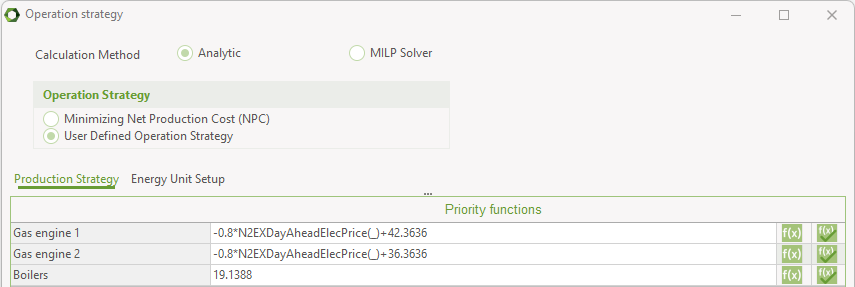

If “Minimizing Net Production Cost” is selected the operation strategy table is substituted by a graphic representation of the Net Heat Production Cost for energy production units as function of the electricity spot prices.
If “User Defined Operation Strategy” is selected the priority of productions tab has a priority functions input field instead of the period divided input seen in fixed tariffs.
When swapping from “Minimizing Net Production Cost” to “User Defined Operation Strategy”, the priority functions will initially be generated automatically based upon the values behind the “Minimizing Net Heat Production Cost” graphics. The functions in the example above are linear functions identical with the lines in the graph above.
Functions available for creating priority functions can be seen by pressing the Fx-button. Available functions are symbols from time series and time series functions and some mathematical functions.
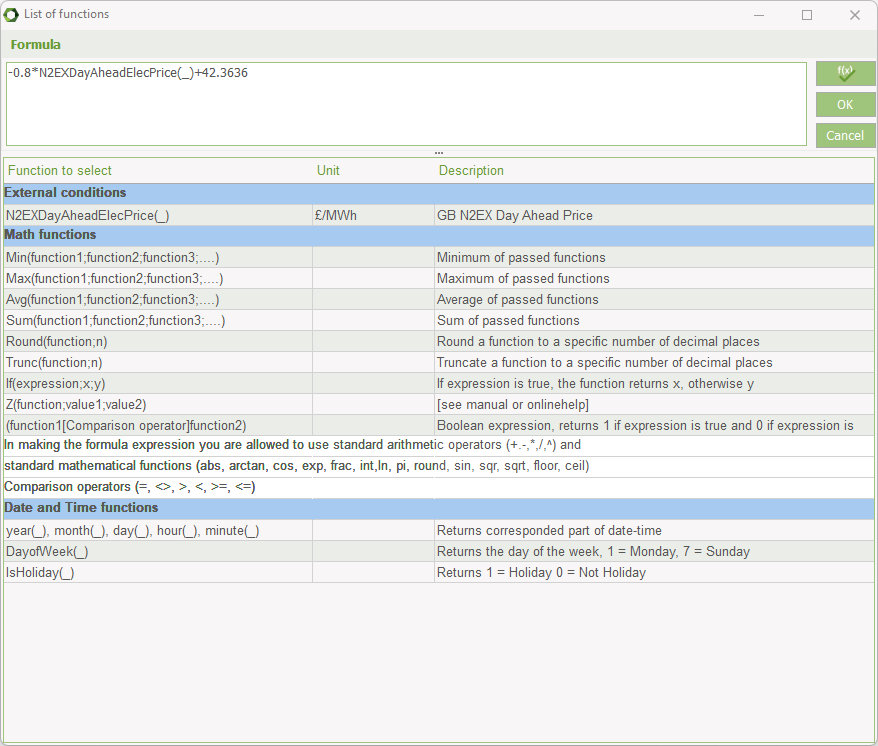
Pressing the test –button checks that the specified function expression is valid.
Automatic calculation of operation strategy – How is it done?
The basic idea behind the automatic operation strategy calculations in energyPRO is that the “Net Heat Production Costs”, and “Net Cooling Production Costs” if a cooling demand is added, are calculated for each production unit in all time intervals. For instance, if there is six tariff periods in a fixed tariff calculation, six prices for the “Net Heat Production Costs” and “Net Cooling Production Costs” are calculated for each of the production units, forming a priority table. When calculating the energy conversion, energyPRO first places as much production as possible on the production unit/tariff period combination represented by the smallest value in the priority table. Hereafter the production unit/tariff period represented by the second smallest net heat production cost will get as much production as possible, etc. This is done until all demands are met or the production opportunities are exhausted. Also see Methods, Analytic Solver.
The calculation of the operation strategy is entirely based upon the “Revenues” and the “Operation expenditures” set up by the user to describe the Operation income. Therefore it is of crucial importance that these payments are set up properly, prior to the energy conversion calculation. The energy and economy calculation are tied together and will affect each other. The operation strategy is calculated for each month in the planning period.
The methodology for calculating the operation strategy is an incremental approach where each of the heat-producing units is calculated as stand-alone units producing one MWh-heat, and each of the cooling producing units as producing one MWh-cooling. In this calculation, all the payments in “Revenues” and “Operation expenditures” are evaluated and calculated. The calculation is repeated for each production unit in each electricity tariff period.
This is the case for production units with heat production. Shown below the heat-producing units in energyPRO. This is CHP, Boiler, Electrical heat pump and User defined. Note that a “User defined” production unit needs a heat production typed into the power curve.
Process heat
Process heat is treated like heat when it comes to calculating Net Production Costs. If a unit has both heat production and process heat production the combined capacity of the two types is used for calculating the Net Production Costs.
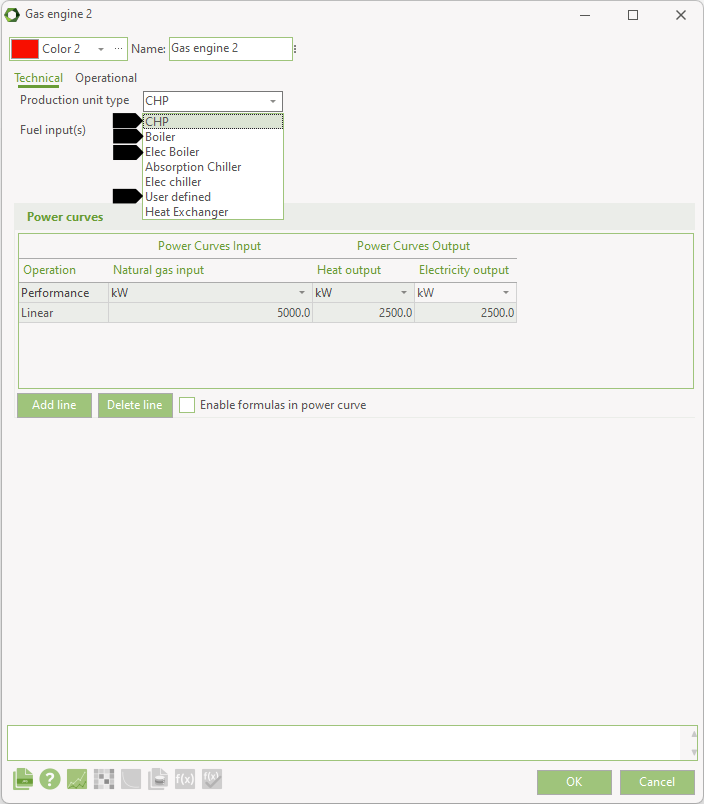
Photovoltaic and Wind farms are always set to a priority higher than all heat-producing units. Hereafter the heat producing units are calculated followed by the cooling producing units. Of the cooling producing units the absorption chillers are calculated first and finally the electric chillers.
The priority of the absorption chiller is defined as Max allowed heat production cost. Meaning, that if the Absorption chiller is to produce cheaper than the electric chiller in the same time interval, then the heat producing unit must have a heat production cost lower than Max allowed heat production cost.
If a payment is the same for all productions units in all tariff periods the payment is ignored. By other words fixed payments not related to the operation of production units are eliminated.
In annex D is shown how the formulas that may occur when describing the payments, are interpreted when being used to calculate the operation strategy.
Each month new operation strategies are calculated. By selecting a month in the project period, the corresponding operation strategy is calculated and shown in the table as shown below.
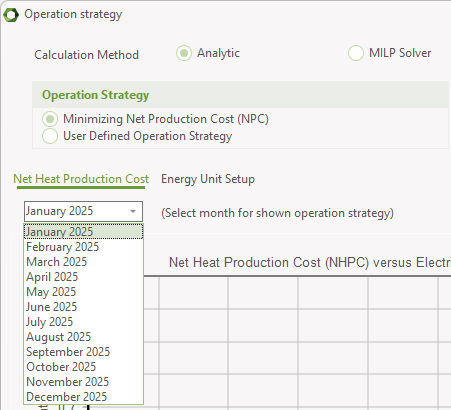
Limitations in use of the automatic calculation of Operation Strategy
If the fuel production option is enabled, as indicated below, then only the user defined operation strategy is available.

Heat rejection table
The heat rejection table is only visible if a heat rejection unit is defined (an Energy Conversion Unit). The heat rejection table is located in the Energy Unit Setup tab.
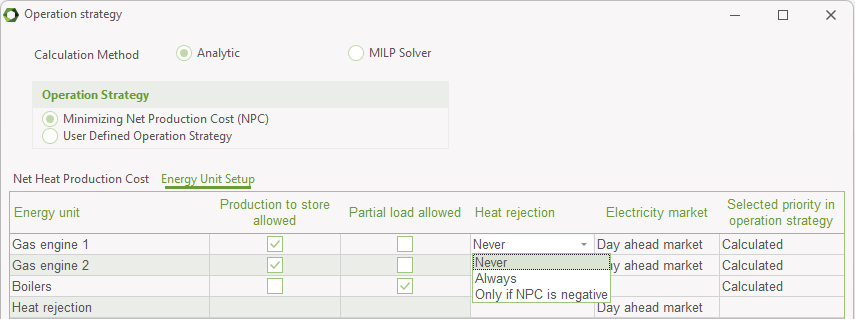
In the heat rejection table there are three options. These are that the energy production unit 1) always has access to blow off, 2) never has access to blow off and 3) the units have access to blow off only if the units are able to produce heat at negative heat production costs. An example hereof could be hours with high prices at the spot market.
Miscellaneous table
There are five standard columns in the miscellaneous table, those are:
- Production to thermal store allowed (only visible if a thermal store is specified)
- Transmit to other sites allowed (only visible if there is more than one site in a project)
- Partial load allowed
- Selection of electricity market
- Selected priority in operation strategy (only visible if the operation strategy is auto calculated )
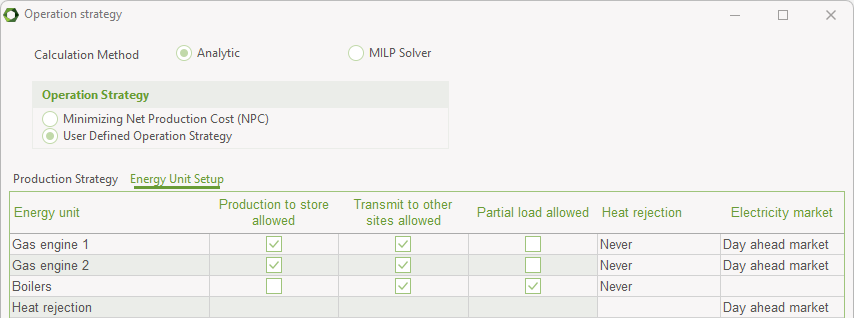
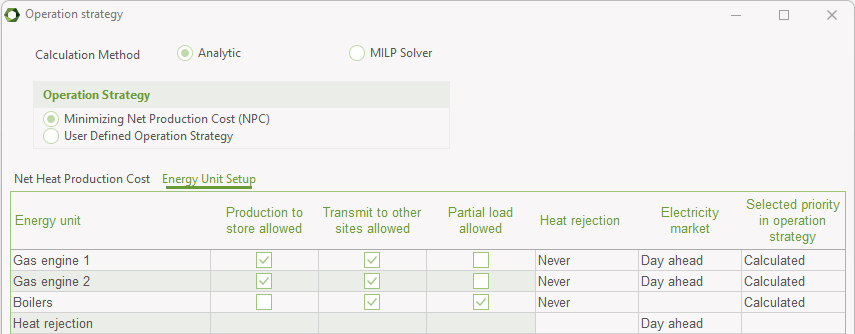
ad 1) State whether the production units have access to the storages.
ad 2 ) State whether the production units are allowed to transmit energy to other sites.
ad 3) State whether the production units are allowed to run on partial load.
ad 4) If the operation strategy is auto calculated "Selected priority in operation strategy" column give the opportunity to overrule the predefined standard settings, which are:
- Boiler: calculated
- CHP: calculated
- Elec. Heat pump: calculated
- Elec. boiler: calculated
- User defined unit: calculated
- Absorption cooler: calculated
- Electric cooler: calculated
- Wind farm: High
- Solar collector: High
- Photovoltaic: High
If an electricity market is added to the model a new column is opened in the miscellaneous table in the operation strategy. This table contain a drop-down box in which it is possible to select between the different electricity markets (It is only possible to have more than one electricity market if MARKETS module is activated). This is done for each production unit that are producing and/or consuming electricity.

If electricity demand(s) are defined in the project a market has to be selected as for the production units. Note that all demands are pooled in this table and subsequently attached to the same market.

The Island Operation Strategy
If you have created an electricity demand in your project, you will in the Operation strategy-window be able to choose "Island operation".

When "Island operation" is chosen, the operation will not be focused on optimizing the electricity productions at the chosen electricity markets, but will be focused on covering the electricity demand (at “the island”). The "island" is not necessarily a real island, but could be a local area, that has focus on covering its own electricity demand.
In such a project there will often be a heat and/or cooling demand to be covered (at “the island”). It has equal priority to cover these demands.
The produced heat to cover the heat demand can be stored for a longer period in a thermal store.
The produced electricity to cover the electricity demand can be stored for a longer period in e.g. a hydro pumping storage.
The produced cooling to cover the cooling demand can be stored for a longer period in a cold store.
In the Operation strategy window you may choose User Defined Operation Strategy to determine in which order the production units will be put in operation.
You may also choose to accept the suggested operation strategy determined by the net heat production costs. In this version of energyPRO you will then have to decide yourself the priority of the production units that do not produce heat but produce electricity. For these units you can choose between High priority and Low priority, compared to the production units producing heat.
You are NOT able to decide the priority of a hydro pumping storage. Excess electricity (compared to the electricity demand) will be stored in the hydro pumping storage (if possible).
In hours where the production units are not able to cover the electricity demand, the hydro pumping storage will try to deliver the rest (perhaps limited by the capacity of the hydro pumping storage).
When "Island operation" is chosen, you can further choose between:
- NO connection to the electricity market
- Needed exchange with the electricity market
If "Needed exchange with the electricity market" is chosen, production units with excess capacity will be allowed to export (Exported electricity) and not covered electricity demand will be covered through import (Imported electricity).
Only production units with a negative number in the “Priority of production” section of the “Operation strategy” are allowed to export.